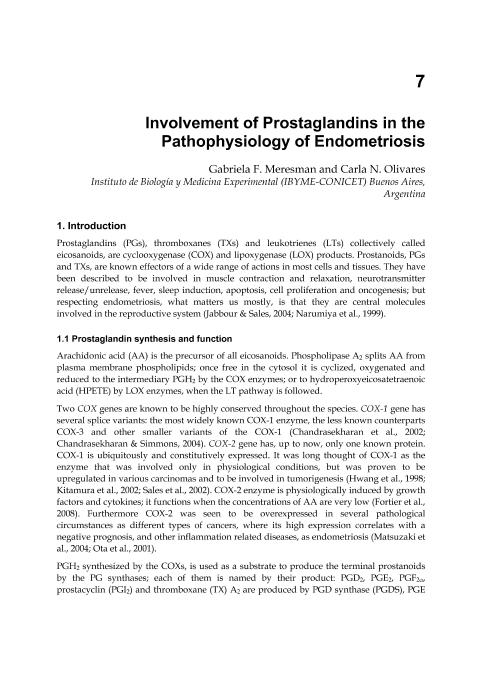Mostrar el registro sencillo del ítem
dc.contributor.author
Meresman, Gabriela Fabiana

dc.contributor.author
Olivares, Carla Noemi

dc.contributor.other
Chaudhury, Koel
dc.date.available
2021-04-27T20:03:18Z
dc.date.issued
2012
dc.identifier.citation
Meresman, Gabriela Fabiana; Olivares, Carla Noemi; Involvement of prostaglandins in the pathophysiology of endometriosis; IntechOpen; 2012; 115-132
dc.identifier.isbn
978-953-51-0524-4
dc.identifier.uri
http://hdl.handle.net/11336/130924
dc.description.abstract
Prostaglandins are bioactive lipids that possess multiple and diverse functions. In reproductive biology, they are involved in the regulation of ovulation, in endometrial physiology and in the process of menstruation. Furthermore, cyclooxygenases (COX) levels, which are key enzymes for the synthesis of prostaglandins, have been found to be elevated in pathologic, tumoral and inflammatory processes. In endometriosis, prostaglandins are not only implicated in pain, but they are also critical for the establishment as well as for the development of the disease. The high levels of prostaglandin E2 (PGE2) found in the peritoneal fluid from patients with endometriosis, not only favor cellular proliferation by stimulating the activity of aromatase with the consequent estrogen production, but also these estrogens are responsible for enhancing PGE2 synthesis by stimulating COX-2 activity. PGE2 also stimulates angiogenesis and is implicated in the peritoneal immunologic alterations observed in endometriosis. COX-2 inhibitors were and are used in a vast number of preclinical and clinical studies in different types of cancer. In studies conducted both in vitro and in vivo, we have demonstrated that the selective COX-2 inhibitor, celecoxib, was efficient in inhibiting experimental endometriosis. It is important to search for new horizons in endometriosis treatment. Prostaglandins and the enzymes in charge of their synthesis, COXs, represent an attractive target for developing new therapies that attack directly the molecules involved in the causes of this pathology.
dc.format
application/pdf
dc.language.iso
eng
dc.publisher
IntechOpen

dc.rights
info:eu-repo/semantics/openAccess
dc.rights.uri
https://creativecommons.org/licenses/by-nc-sa/2.5/ar/
dc.subject
ENDOMETRIOSIS
dc.subject
PROSTGLANDIN
dc.subject
COX-2
dc.subject.classification
Obstetricia y Ginecología

dc.subject.classification
Medicina Clínica

dc.subject.classification
CIENCIAS MÉDICAS Y DE LA SALUD

dc.title
Involvement of prostaglandins in the pathophysiology of endometriosis
dc.type
info:eu-repo/semantics/publishedVersion
dc.type
info:eu-repo/semantics/bookPart
dc.type
info:ar-repo/semantics/parte de libro
dc.date.updated
2020-08-05T17:15:56Z
dc.journal.pagination
115-132
dc.journal.pais
Croacia

dc.description.fil
Fil: Meresman, Gabriela Fabiana. Consejo Nacional de Investigaciones Científicas y Técnicas. Instituto de Biología y Medicina Experimental. Fundación de Instituto de Biología y Medicina Experimental. Instituto de Biología y Medicina Experimental; Argentina
dc.description.fil
Fil: Olivares, Carla Noemi. Consejo Nacional de Investigaciones Científicas y Técnicas. Instituto de Biología y Medicina Experimental. Fundación de Instituto de Biología y Medicina Experimental. Instituto de Biología y Medicina Experimental; Argentina
dc.relation.alternativeid
info:eu-repo/semantics/altIdentifier/doi/http://dx.doi.org/10.5772/30414
dc.relation.alternativeid
info:eu-repo/semantics/altIdentifier/url/https://www.intechopen.com/books/endometriosis-basic-concepts-and-current-research-trends/involvement-of-prostaglandins-in-the-pathophysiology-of-endometriosis
dc.conicet.paginas
490
dc.source.titulo
Endometriosis, Basic Concepts and Current Research Trends
dc.conicet.nroedicion
1ra
Archivos asociados
